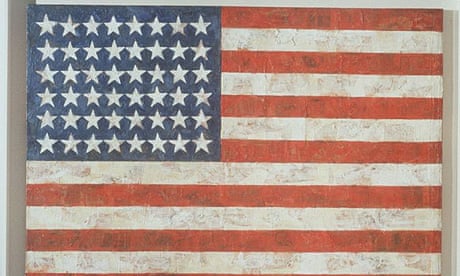The American flag becomes a fraught ambiguous thing, at once object and history, public icon and secret diary, in Jasper Johns' revelatory masterpiece painted - or is the right word "made"? - in 1954 or 1955. It is a painting that is also a sculpture. At first, what you see is simple: the stars and stripes, love 'em or hate 'em. Look closer - and this is, profoundly, a work of art to experience in itself. In the original - owned by New York's Museum of Modern Art since the 1950s - you start to see are fragments of headlines and photographs clipped from newspapers, sunk beneath the soft waxen surface of the work. Johns painted Flag using the encaustic method, an ancient art form in which pigments are suspended in hot wax.
Mummy portraits from the Fayoum delta use encaustic methods to create astonishingly sharp images of faces. Johns uses it to build a flag that is more solid and more substantial, somehow more real, and yet also more complex and infinitely more enigmatic, than an actual flag.
Instead of capturing the waving motion of a banner held aloft - as Uccello does in The Battle of San Romano and as, in an American context, Emmanuel Gottlieb Leutze does in his stirring 1851 history painting Washington Crossing the Delaware - Johns freezes its motion. His flag will never flutter. It is a monument to a flag: the flag mummified.
In its stilled lucidity lurk half-readable stories: the small-fry stuff of yesterday's papers, or important events? Do they add up to some secret meaning? There is the sense of many lives, many narratives hidden beneath the common identity of Americans. This painting, this artwork, is like a great American novel. It captures in its monumental ghostly depths the intricate truths every simple facade conceals. Who are Americans? What are they like? The truth lies deeper than the stars and stripes.
An election - and another great political work by Johns is his painted map of the US - is a collage, a moment when the fragments of torn reality rise up out of the flag's prison to reveal themselves for what they are. Hope and fear are pressing now against the encaustic.

Comments (…)
Sign in or create your Guardian account to join the discussion